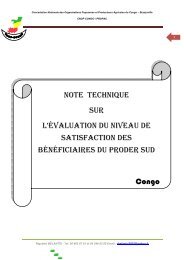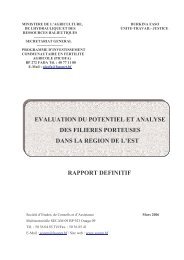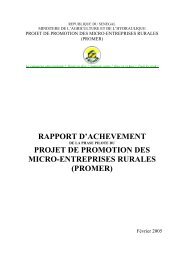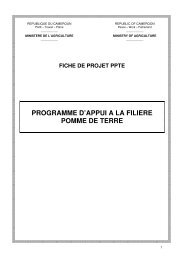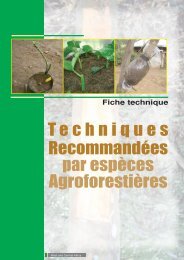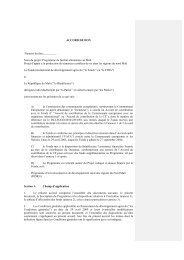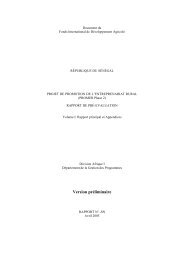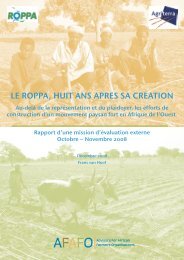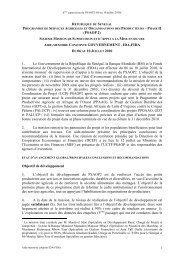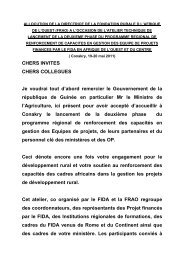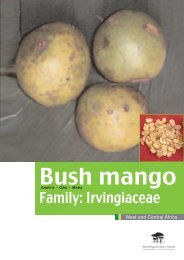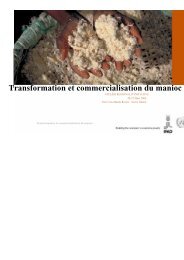Scaling Up the Fight Against Rural Poverty - FIDAfrique
Scaling Up the Fight Against Rural Poverty - FIDAfrique
Scaling Up the Fight Against Rural Poverty - FIDAfrique
Create successful ePaper yourself
Turn your PDF publications into a flip-book with our unique Google optimized e-Paper software.
O<strong>the</strong>r examples of scaling up include a technical assistance grant to <strong>the</strong> World Agroforestry Centre<br />
(ICRAF) for <strong>the</strong> Diversification of Smallholder Farming Systems in West and Central Africa through<br />
Cultivation of Indigenous Trees, which among o<strong>the</strong>r results has led to a gradual reduction in <strong>the</strong><br />
practice of slash-and-burn agriculture in <strong>the</strong>se humid tropics areas; a grant for <strong>the</strong> Africa Rice Center<br />
which enables it to scale up successful methods of participatory varietal selection and a communitybased<br />
seed system approach, with a focus on IFAD loan projects; and <strong>the</strong> provision of nearly 23,000<br />
‘biodigester’ tanks for biogas production to approximately 30,000 poor households in West Guanxi,<br />
China. 18<br />
A final example of <strong>the</strong> potential for scaling up in ENRM, and IFAD’s growing interest in this topic, is<br />
a just completed study of <strong>the</strong> experience around <strong>the</strong> globe with wea<strong>the</strong>r index insurance to help<br />
protect farmers from wea<strong>the</strong>r-related risks to crop production. Entitled “The Potential for Scale and<br />
Sustainability in Wea<strong>the</strong>r Index Insurance for Agriculture and <strong>Rural</strong> Livelihoods” (IFAD 2010b) this<br />
study focuses specifically on <strong>the</strong> potential for designing scaled up and sustainable interventions and<br />
as such represents an excellent example of <strong>the</strong> approach which IFAD should explore in o<strong>the</strong>r <strong>the</strong>matic<br />
areas to explore <strong>the</strong> lessons of experience (its own and that of o<strong>the</strong>rs) for scaling up and sustaining<br />
successful interventions.<br />
Despite <strong>the</strong>se examples of an effective focus on scaling up in selected cases, it appears that scaling up<br />
has not been at <strong>the</strong> core of IFAD’s ENRM activities. However, <strong>the</strong> experience to date will be helpful<br />
in exploring how to incorporate scaling up into IFAD’s future ENRM strategy, including its stress on<br />
<strong>the</strong> more effective use of data collection, sharing and use in planning processes, its references to<br />
mapping and assessment tools that can help define <strong>the</strong> relevant scale of intervention, its focus on <strong>the</strong><br />
policy and institutional context, and its emphasis on <strong>the</strong> need to mainstream climate change aspects<br />
more effectively into IFAD’s traditional ENRM interventions.<br />
2. <strong>Scaling</strong> up with value chains<br />
Value chains offer a “vertical” form of scaling up by focusing not merely on <strong>the</strong> poor farmer, but on<br />
<strong>the</strong> pathway from producer to consumer. Of course, projects with interventions designed to help <strong>the</strong><br />
development of an effective value chain do not necessarily mean that one expands <strong>the</strong> number of<br />
beneficiaries in a significant way, since <strong>the</strong> project itself may be narrowly focused on a limited number<br />
of participants or <strong>the</strong>re may be constraints on <strong>the</strong> supply or demand side which make it impossible to<br />
scale up <strong>the</strong> value chain horizontally, i.e., expand its scope so that it covers increasingly more<br />
beneficiaries.<br />
IFAD’s explicit focus on value chains is of recent origin. There is hardly a mention of value chains in<br />
<strong>the</strong> Strategic Framework 2007-2010 (IFAD 2007), although <strong>the</strong> Framework devotes considerable<br />
attention to market access, which is a key component of a value chain approach. By 2010, value chains<br />
had moved to <strong>the</strong> core of IFAD’s thinking, as reflected in various recent speeches by IFAD’s<br />
President, a speech by <strong>the</strong> IFAD’s Assistant President and various o<strong>the</strong>r public pronouncements. 19 And<br />
various projects focused specifically on value chains are now under implementation or preparation. In<br />
fact, according to President Nwanse’s speech in Nigeria on 10 March 2010, “[i]n value terms, <strong>the</strong> total<br />
18 These examples are cited in <strong>the</strong> previously mentioned internal NREM review by IFAD.<br />
19 President Kanayo Nwanze addressed this issue in speeches at Chatham House, London, on 2 November 2009;<br />
at <strong>the</strong> UNIDO general conference on 7 December 2009; and at <strong>the</strong> High-level Conference on Development of<br />
Agri-business and Agro-industries in Africa, in Abuja, Nigeria, 10 March 2010 (see<br />
http://www.ifad.org/events/op/index.htm). Assistant President Kevin Cleaver raised <strong>the</strong> issue of value chains in<br />
his presentation to IFAD’s Executive Board on 14-15 September in Rome. And IFAD made a presentation at <strong>the</strong><br />
WTO Workshop on Aide for Trade and Agriculture Supporting Smallholder Integration into Agricultural<br />
Markets: Lessons from IFAD’s Experience, on17 March, 2010.<br />
24



